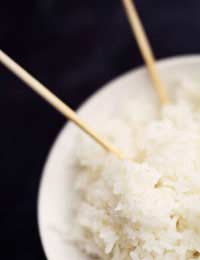How to Cook Rice

Rice is one of those foods that you'll drop into your shopping trolley without actually planning any meals around it. It helps to fill up the cupboard it's a staple, it's cheap but it's often neglected and left to languish with the remains of pasta shapes that don't match newer packets but aren't quite sufficient to make a meal on their own.
Rice is very easy to cook but it's also very easy to get wrong. It's nutritious, filling and versatile and yet it doesn't always get used to its full advantage. Plain, boiled rice might be served up as an accompaniment to a jar of curry as a stand-by meal and, although there's nothing wrong with that, it can be so much more exciting!
The Knowledge
Long GrainThis is the one that's probably in your cupboard at home. Although there are many different types of long grain rice, the most common is suitable for use in all kinds of dishes so it's very versatile.
Basmati
This is the traditional accompaniment to Indian food. It has a thinner, more delicate grain and is generally considered to be the highest quality rice. As it has a delicate grain, it cooks quite quickly, which is why people so often end up with a glutinous pile of stodge. You should rinse if thoroughly and really keep a close eye on it while cooking, testing it every couple of minutes. When cooked, drain and rinse through again with boiling water.
Brown Rice
The healthy option but also a tasty one. The grains aren't milled (as they are with white rice) so it's more of a complete grain and there's more goodness. Brown rice is a slow-release carbohydrate so good for all you GI (glycaemic index) enthusiasts. It takes about 30 minutes to cook so it's not a good choice for a really speedy meal.
Risotto Rice
You'll see two main varieties of risotto rice in the supermarket: carneroli and Arborio. These have a short, thick grain that is capable of absorbing up to three times its weight in liquid, making it ideal for risotto dishes. The key to a good risotto is patience - you need to stand by the pan and stir constantly, gradually adding the liquid.
Cooking to Perfection
Follow these steps and your rice should be wonderfully fluffy, with nice separate grains, every time you cook it.- Always rinse rice thoroughly before you cook it. This removes a lot of the excess starch, which can make rice very stodgy and sticky. (The exception to the rule is when cooking risotto, as this is the consistency you're aiming for.)
- Measure the amount of rice into a large pan, cover with cold water and swirl the rice around with your fingers. Drain and repeat until the water runs off clear.
- Transfer the rice into a colander then fill the pan with water and bring to the boil.
- Meanwhile, bring a kettle of water to the boil.
- Simmer the rice according to packet instructions and begin testing the rice a few minutes before the recommended cooking time. Keep doing this until you're happy the rice is cooked.
- Drain thoroughly in a colander and, if you like, you can pour the water from the kettle over the rice for one final rinse.
- If you're not ready to serve the rice, return it to the pan and cover.


Re: Working Out a Food Budget
Great advice! Setting a food budget is all about balance, and these tips really help to keep things manageable without compromising on…
Re: How to Make Basic Sauces
nice, but i think it would be better if you had, like, satay sauce, and garlic dip. but still, nice.
Re: Organising Your Kitchen
how do l cook jollof rice and frid rice..also vegetable soup..
Re: Dinner in 10 Minutes
What else can you do with jacket potato I have butter and a bit of gravy with mine
Re: The Quick Guide to Great Cooking
i'm a student want to learn more basic sauce and any additional ingredients for cream sauce white sauce.thank you
Re: Ten Ideas for Jacket Potatoes
Please could you add pictures of the goods if possible.
Re: How to Cook Fish
Your advice on poaching (and other ways of cooking) haddock seems very sensible and in touch with real life. This ( I know comparisons are odious…
Re: Ten Ideas for Jacket Potatoes
Could you help me with easy toppings for jaket bbq bake potatos ,for to cook 30 at a time need some help ,so come all you great…
Re: Meals for £1
Bb - Your Question:Students don't have luxrys like oil and an onion just hanging about or pepperOur Re
Re: Cooking in Bulk
Go into supermarkets late in the day and pick up reduced veg, Take home cut up in dinner portion Bags up in freezer bags Put in freezer til you…